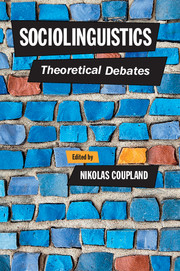Book contents
- Frontmatter
- Contents
- List of contributors
- Preface and acknowledgements
- 1 Introduction: Sociolinguistic theory and the practice of sociolinguistics
- Part I Theorising social meaning
- 2 The “push” of Lautgesetze, the “pull” of enregisterment
- 3 Variation, meaning and social change
- 4 Indexicality, stance and fields in sociolinguistics
- 5 Sociolinguistic differentiation
- Part II Language, markets and materiality
- Part III Sociolinguistics, place and mobility
- Part IV Power, mediation and critical sociolinguistics
- Part V Sociolinguistics, contexts and impact
- Part VI The evolution of sociolinguistic theory
- Index
- References
5 - Sociolinguistic differentiation
from Part I - Theorising social meaning
Published online by Cambridge University Press: 05 June 2016
- Frontmatter
- Contents
- List of contributors
- Preface and acknowledgements
- 1 Introduction: Sociolinguistic theory and the practice of sociolinguistics
- Part I Theorising social meaning
- 2 The “push” of Lautgesetze, the “pull” of enregisterment
- 3 Variation, meaning and social change
- 4 Indexicality, stance and fields in sociolinguistics
- 5 Sociolinguistic differentiation
- Part II Language, markets and materiality
- Part III Sociolinguistics, place and mobility
- Part IV Power, mediation and critical sociolinguistics
- Part V Sociolinguistics, contexts and impact
- Part VI The evolution of sociolinguistic theory
- Index
- References
Summary
Introduction
Early work in sociolinguistics offered key insights for studying the social meanings of linguistic differentiation. Three of these remain strong inspirations for current research programs. First, there was a deep understanding that many apparently different disciplinary approaches were closely related and together would shed light on linguistic variation and change. Dialectology, ethnographies of communication, conversation analysis, and studies of standardization and of language politics sat comfortably side-by-side in the early edited collections (Hymes 1964; Bright 1966). In a second insight, researchers proposed that all social signaling occurs in interaction of some kind: Linguistic changes correspond to shifts in the social situation (Fischer 1958; Hymes 1962; Labov 1963; Gumperz and Hymes 1964). In studies of communication, a concern with reflexivity was present from the start. Anthropologist Bateson (1955) highlighted the necessity of metasignals that give cues to listeners about how they should understand or respond to utterances. Jakobson (1960) discussed the metalinguistic (i.e., reflexive) function of language. Both theorists recognized that many levels of linguistic structure can carry metamessages, and such signaling occurs in every kind of interaction and social group. A third insight followed: If the selective display of linguistic variants can signal the definition of situation, it can also reconstruct it. Linguistic variation does not simply reflect but also performatively creates social meaning that is a spur and enactment of social differentiation (Labov 1963; Blom and Gumperz 1972). In this way, linguistic variation participates in sociocultural as well as linguistic change.
In the sociolinguistics research that developed from these early insights, metasignaling has been understood as a semiotic process: A metasign is one that regiments how it itself and other signs are to be interpreted; it is a framing. Language ideologies in all their more-and-less explicit forms do just this work. Among all the many possible effects of metasignaling, this chapter focuses on the achievement of similarity and difference – between linguistic forms, speaker personae, social roles, situations, objects of talk. Similarity and difference are like two sides of a coin; they result from mutually implicated sociolinguistic processes. My question is: How are the resemblances and contrasts of sociocultural and linguistic practices actively constructed by framings and uptakes of signs? The sign relation of indexicality has been most thoroughly examined in sociolinguistics so far.
- Type
- Chapter
- Information
- SociolinguisticsTheoretical Debates, pp. 113 - 136Publisher: Cambridge University PressPrint publication year: 2016
References
- 39
- Cited by



